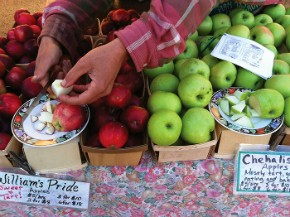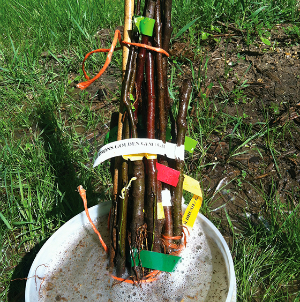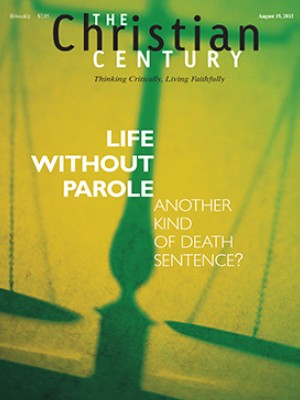Heirloom apple trees: Notes from the farm

The apple trees were delivered just after I’d left for the weekend. From afar, I fretted over them like a mother hen. Would they get too hot? Would their roots dry out? Would the promise of heavy branches bending earthward be fulfilled in three, five, ten years . . . or never?
As soon as I got back home I rushed to the tall cardboard box propped under the eaves and tore it open. The tiny brown sticks with straggly bare roots seemed pitiful, more dead than alive. I filled a bucket with water and plunged the bundle in.
Much livelier than the tiny trees were their brightly colored labels. I fingered the plastic tag wrapped around each twig and read out their names like an incantation: Esopus Spitzenburg, Hudson’s Golden Gem, Puget Spice, Bonkers, GoldRush, Chestnut Crab, Sansa, Porter’s Perfection. Some were heritage varieties from hundreds of years ago and some were more recent crosses, but all were chosen, by the nursery and by me, for their stellar tastes. These apples were nearly lost over the last century of commercial agriculture, and so my baby trees were worth fretting over. But there was nothing to do now except let them soak and then plant them later in the day.
Read our latest issue or browse back issues.
The best time to plant a tree, a Chinese proverb begins, was 20 years ago. The second best time, it concludes, is now.
I ordered my bucket of trees after an irresistible impulse to plant now! It was prompted by an e-mail from my favorite heirloom fruit tree nursery, offering an end-of-season sale. With scarcely a thought, I bought. Even though my package was a mystery grab bag. Even though there was a ten-tree minimum. And even though I have room for only two more trees in my little orchard.
But with names like Esopus Spitzenburg, Freyberg, and Bonkers, how could I resist? The nursery site’s descriptions sealed the deal. I learned that the Spitzenburg originated in Esopus, New York, around 1790, and was one of Thomas Jefferson’s favorite apples. To our eyes it looks funny, even unappetizing, with a conical shape and tough, mottled, orangish skin. But underneath that skin is an aromatic and rich-tasting apple with spicy acidity balancing the sweetness. To top it off, the Esopus Spitzenburg is an excellent winter keeper whose taste improves with storage, usually peaking around Christmastime.
The Freyberg is another apple that would strike the modern shopper as unattractive, with its yellow-green russet skin. But its creamy white flesh is firm and juicy, with a taste described as a mixture of apple, pear, and banana, with a touch of anise, licorice, and overripe raspberry.
With tastes of Freybergs and Spitzenburgs dancing in my head, I leapt at the chance to get ten unknown fruit trees for only $5 each—which was not as crazy as it might seem, since my father and two of my sisters have orchards, and I figured they could be persuaded to take the extra eight trees off my hands.
“One reason I always wanted an orchard,” my sister Teresa, an organic fruit farmer, says, “is for it to be here after I die. Somehow it will let me live for at least another generation when my grandchildren tell their children that Great Grandma Teresa planted the tree that the apple they are eating came from.”
This is a sentiment expressed by apple growers throughout the centuries. In The Apple Culturist (1871), Sereno Edwards Todd wrote: “There is no way a man can so effectually rear a monument to posterity, and one for which he shall receive their blessing, as by planting a fruitful apple orchard that shall yield a luxury in its wealth of delicious fruit.”
I have different, vaguer reasons for my late-onset passion for fruit trees. I remember climbing up in the gnarled old Kieffer pear trees at my grandparents’ farm before they were bulldozed to make way for more corn. And a full-size apple tree dominated the backyard of my childhood, its limbs providing a cool and leafy refuge during hot summer afternoons. Not only was this a grand and climbable tree, it bore three kinds of apples. And so I was lucky to be immersed in the art and science of grafting from a young age.
Grafting is a surprisingly simple yet almost magical technique of inserting a piece of one plant into another so that their vascular tissues join together and the two plants grow as one. The top part of the plant (called the scion) is chosen based on what you want that tree to bear—say, Bartlett pears or Winesap apples. In the case of the big apple tree in the backyard of my childhood, three scions were chosen: Red Delicious, Yellow Delicious, and Granny Smith.
While the aboveground portion of a fruit tree gets all the attention, the rootstock is arguably the more important part and confers many advantages. For example, a certain rootstock may be adapted to heavy clay soils, or may cause the plant to flower and bear fruit early (precociousness) so that you get apples even if your growing season is very short. More and more rootstocks make trees resistant to diseases, especially the deadly fire blight, a contagious bacterial disease that spreads through a tree like gangrene, causing the leaves to almost instantly wilt, turn brown, and fall off. And most rootstocks are chosen to make trees grow slowly so that you get apples that are easy to reach from the ground.
Because I have a small orchard space, I asked for dwarfing rootstock. All of my trees came on G.11 rootstock developed by the New York State Agricultural Experiment Station in Geneva (hence the “G”). This rootstock also makes the trees moderately resistant to fire blight. Conventional growers spray their trees with antibiotics, but as organic growers, we do not. As soon as we notice any blight we amputate the affected limbs, but even then you can’t always save the tree.
Thinking that fire blight resistance is a very good thing, I get my spade and shovel and bring the trees over to the edge of my orchard where there’s still space for a few more trees. I use the spade to break open the earth, first by cutting a circle two feet in diameter through the thick sod, then by cutting horizontally through the grass roots. I peel back a pancake of sod and earth and breathe in the clean, yeasty smell of life. I trade the spade for the shovel and dig out the soil—black for a few inches and then heavy brown clay—until I have a hole about two feet deep.
I mix some of the good black dirt from the top into the clay at the bottom, and create a small hill at the bottom of the hole to help the roots radiate out in all directions. Given decent soil and enough sun and rain, an apple tree’s roots will spread two to three times farther down than the branches go up. Those deep roots bring up water, of course, but they also tap mineral reserves deep in the soil. The minerals become part of the tree so that in the autumn, when the tree’s leaves fall, those minerals, now in an organic form, return to earth and become part of the humus, thus renewing and regenerating the upper levels of the soil. Over decades, the patch of earth where an orchard is planted becomes richer and more fertile than the surrounding land. By leaving a patch of earth better than I found it, I’m applying the Golden Rule across generations.
 |
Now the time has come to decide which two trees in my bucket of ten to plant. I had planted a Bonkers the year before, so I choose the Freyberg and the Esopus Spitzenburg. I make the hill of soil in the bottom of each hole the right height so that the graft union of the tree ends up 3–4 inches above the surface. If it’s any closer to the ground, the scions will establish their own roots, which then override the desired effects of the rootstock.
I mound the soil, position the trees, fan out their roots, and then put soil all around the roots, tamping it firmly, making sure each little root makes good contact with the soil. When the holes are half filled with soil, I pour in half a bucket of water to force out any air trapped in pockets. Then I fill the remainder of the holes, again tamping firmly with my hands. Finally, I do a little dance around the newly planted trees to firm the soil even more before giving them their first long drink in their new home.
As I dig the holes and touch the soil, the roots, the water, and the pencil-thin trees with their little scar where the rootstock joined with the scion, I acknowledge my responsibilities to love and care for these trees—in sickness and in health—through fire blight, insects, late frosts, and ravenous deer, mice, voles, and rabbits. With these and so many other things that can go wrong, each apple that may grace these trees and my table years from now will be a small miracle. And every spring, when the fruit trees bloom, hope too will blossom anew. And so we embrace our mutual destiny, me and the trees, so long as we both shall live.
A few days later my sister Jill came to pick up the remaining eight trees. Later she wrote to me: “I planted all the trees last Tuesday, and over the weekend we watered and mulched them all. Every one is leafing out nicely. A rabbit munched a couple before I found the plastic protectors, but I think they are OK. We will share in the bounty some day.”






